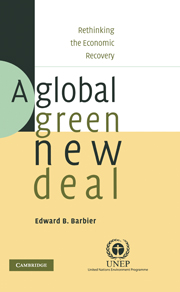Book contents
- Frontmatter
- Contents
- List of figures
- List of tables
- List of boxes
- Foreword
- Preface
- Acknowledgements
- Part I Why a Global Green New Deal?
- Part II The Key Components of a Global Green New Deal
- 2 Reducing carbon dependency
- 3 Reducing ecological scarcity
- 4 Challenges facing developing economies
- 5 National priorities for a Global Green New Deal
- Part III The Role of the International Community
- Part IV Towards a Greener World Economy
- Appendix 1 PIIE–WRI analysis of a green recovery program for the United States
- Appendix 2 Pew comparative analysis of clean energy jobs and investments in the United States, 1998–2007
- Glossary
- Index
- References
2 - Reducing carbon dependency
Published online by Cambridge University Press: 05 June 2012
- Frontmatter
- Contents
- List of figures
- List of tables
- List of boxes
- Foreword
- Preface
- Acknowledgements
- Part I Why a Global Green New Deal?
- Part II The Key Components of a Global Green New Deal
- 2 Reducing carbon dependency
- 3 Reducing ecological scarcity
- 4 Challenges facing developing economies
- 5 National priorities for a Global Green New Deal
- Part III The Role of the International Community
- Part IV Towards a Greener World Economy
- Appendix 1 PIIE–WRI analysis of a green recovery program for the United States
- Appendix 2 Pew comparative analysis of clean energy jobs and investments in the United States, 1998–2007
- Glossary
- Index
- References
Summary
A critical component of the Global Green New Deal is the necessity of reducing the carbon dependency of the world economy.
As indicated in box 2.1, although the greenhouse gas intensity of the world economy may have declined from 1990 to 2005, overall global emissions have risen. They are projected to rise even further over the next twenty-five years, with fossil fuel energy use continuing as global populations increase, the world economy grows and poorer economies develop. Thus, reviving economic growth in today's carbon-dependent world economy will simply contribute to both the rising demand for and combustion of fossil fuels and increased GHG emissions.
In 2005 the top ten emitters of GHGs were either rich economies (e.g. the United States, the European Union, Japan and Canada) or large emerging market economies (e.g. China, Russia, India, Brazil, Mexico and Indonesia). Together, the top emitters accounted for over 70 percent of the world's total GHGs (see box 2.1). By 2030, however, this situation is likely to have changed. Emissions from energy sources alone will more than double for the developing world, increase by nearly 30 percent in transition economies and rise by 17 percent in the OECD. By 2030 developing economies will account for more than a half of the world's GHG emissions from energy use, and China's share could be close to a third. Other large emerging market economies, such as India and Russia, will also continue to contribute significantly to global emissions.
- Type
- Chapter
- Information
- A Global Green New DealRethinking the Economic Recovery, pp. 35 - 96Publisher: Cambridge University PressPrint publication year: 2010



